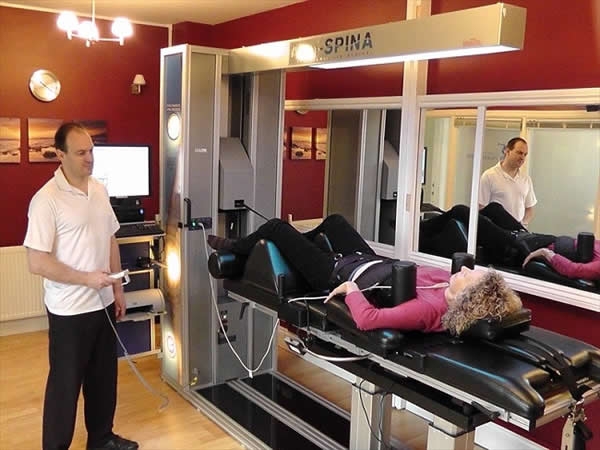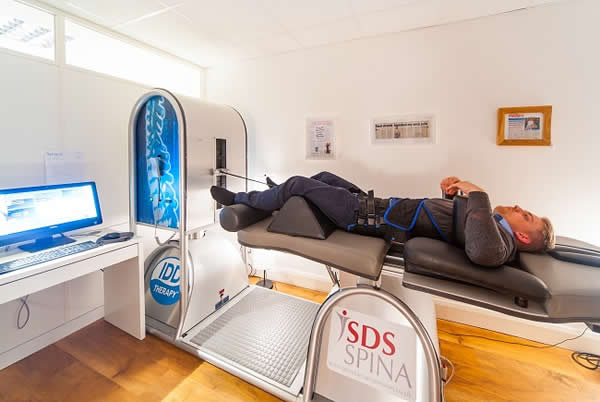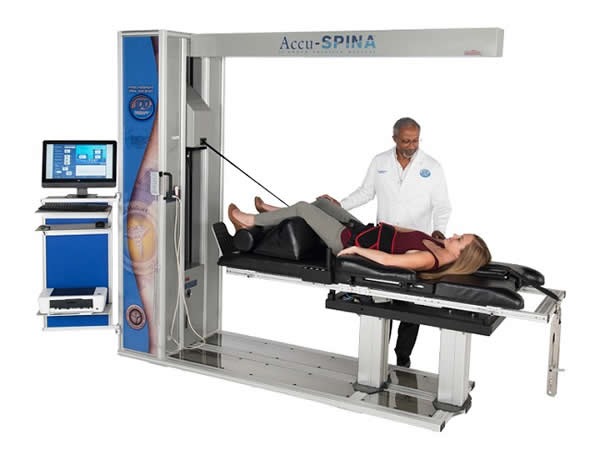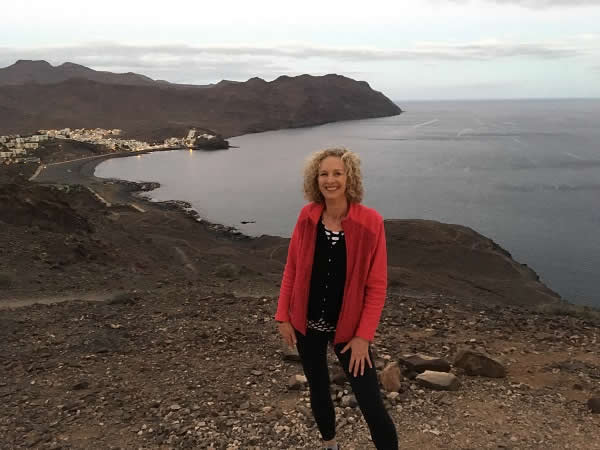Positive Health Online
Your Country

Intervertebral Disk Decompression Cured my Back Pain
listed in back pain, originally published in issue 253 - April 2019
After many years of working as an osteopath, Sally Lansdale was suffering from so much back pain herself, she thought her career had come to an end. A combination of day-to-day bending at work, along with injuries from a car crash and horse-riding accidents in her past, left her unable to sit for more than a few minutes. In her late 50s, Sally went for an MRI scan and as it is for many people, the scan revealed bulges in the discs in her spine.
Not wanting to consider surgery unless absolutely necessary, Sally opted for a non-invasive treatment that involved carefully computer-controlled pulling or decompression forces on targeted areas of the spine. At the time there was only one treatment centre of its kind in the UK and it was available in Glasgow.

Sally undergoing IDD Therapy
Originating from America, IDD Therapy (Intervertebral Disc Decompression) uses a SPINA machine to gently decompress and mobilise specific spinal segments. IDD Therapy uses precisely measured angles and specific pulling forces to treat the affected levels in the back or neck, particularly where there is a disc problem.
It was developed 20 years ago by a team of physicians and engineers who understood that it was always preferable to get the spine moving again rather than take bits out of it through surgery.
“Just the trip itself up to Glasgow for that first treatment was pretty unbearable for me having to sit for all that time,” said Sally.
“But after the first treatment I could tell that IDD Therapy had made a difference, unlike anything I had experienced before.”
“I am so thankful I gave IDD a go because just the next day after that first treatment I was already feeling so much better,” said Sally.
“I was immediately hooked on the machine and the procedure,” she says.
“I know I was very lucky, not everyone sees such instant results, but it was clear I had found something which was really quite special.”

Sally continued the course of treatments and was so impressed by the results that she bought her first machine in 2010, working first out of Herefordshire. Then four years ago, she set up her first Spinex Disc Clinic in London at Edgware Road.
“It was quite daunting to take on the project. There was an empty shell and the clinic was starting from scratch. To begin with I put a poster at the tube station and didn’t get a single call, despite all the people passing by!”
Fortunately, over time, patients started to come and the reputation of the clinic grew. Her second clinic opened at Aldgate last year, as testament to the growing success. There are over 1,000 clinics providing IDD Therapy and a network of 35 clinics in the UK, comprising the IDD Therapy Disc Clinic network. With all her experience, Sally also acts as the principal trainer for new IDD Therapy providers.
“I see people who are in a pretty bad way, often waiting for surgery. If we can save them from having to go through that then it’s a massive boost.” says Sally.
A big portion of her clients, she says, are city workers suffering from sitting at fixed positions at computers and from the use of other modern-day technology.
“I wait for my train at the underground every morning and I see everyone hunched over their mobile phones and I think to myself ‘there’s a whole lot of back and neck problems just waiting to manifest themselves,’” she says.
Patients travel from quite far and the clinic gets a real mix of patients, older as well as young. Sally adds that children can often hurt themselves when they are young and not notice any problems until much later on in adulthood. Many back and neck injuries lie dormant for many years before presenting as a problem.
But she doesn’t promote IDD Therapy as a quick fix. Most people need up to twenty treatments lasting one hour each, three to five times a week for the first couple of weeks.
The treatment includes heating up the muscles first and then cooling them down afterwards. There are also gentle exercises to go along with treatment to help strengthen and support the spine.
“And the success rates are exceptional given that practically all have tried other treatments and failed. Approximately three out of four people get better and for many it makes the difference between being able to carry on working or having to give up. That was why is was such an easy choice for me to have treatment,” said Sally.
“I know a lot of osteopaths now who are no longer practising as much as they would like because of the problems they have with their own backs, ironically from helping others for many years!”

The IDD Therapy process requires people to wear a set of ergonomic harnesses and they lie comfortably on the treatment table. The machine then applies gentle pulling forces to take pressure of the discs and nerves, whilst mobilizing the joints.
“When people damage their backs movement becomes very restrictive. That can lead to a vicious circle where people have pain and become less mobile. The discs especially need movement to stay healthy and as we become stiffer, the discs are unable to absorb water and nutrients to keep them healthy. IDD Therapy is a very natural way of getting the body working again,” said Sally.
“In the past, traditional procedures could take months to get people properly mobile again after a back problem. Now it can be just a matter of weeks.”
But Sally is quick to point out that IDD Therapy doesn’t replace traditional methods of manual therapy.
“Sometimes I will still start people off with a couple of manual treatments to release the shoulders perhaps and them move them on to IDD.
“If someone has damaged a disc in their back or lower neck, I may start with traditional manipulation. IDD works in a complementary way to speed up the healing process.
“There is definitely a need for more than manual therapy alone,” says Sally.
Patients wear loose fitting clothing during treatment and as the treatment is gentle, many actually go to sleep.
Although most of her clients present with back and neck problems, Sally says IDD Therapy can also help with other joints and disfunctions.
She says: “It is really exciting to see the changes in people, to watch them get better in front of your eyes. To see the pain lift from their faces is a great thing.”

Sally Lansdale
Sally always recommends lifestyle changes after the treatments to help avoid relapses and she says an hour of walking a day is really the best thing many people can do.
“They don’t have to sign up for any gyms or learn to use any equipment. Just walk to keep those joints and muscles moving. It’s a free exercise and it’s also good for the mind,” she says.
Sessions cost around between £70 and £90, depending on the area and some insurance companies will pay for it.
“It’s also a fraction of the cost of surgery.” says Sally.
And she adds: “A course of IDD treatment costs about the same as a holiday. I’d rather pay for treatment to get me out of pain than spend another holiday in pain”.
There are many ways to treat back pain. Whilst it is reassuring that most back pain resolves within about six weeks, for people with longer term issues, it can be difficult and frustrating to know where to turn.
Before embarking on any exercise programmes, it is good to get the advice of a professional to make sure that what you are going to do won’t make the situation worse. That might be a physiotherapist, osteopath or chiropractor. The important thing is to be comfortable with the person you are seeing, so always do your research.
When back pain is not resolving, options do become more limited. Injections may help with inflammation but are only intended as a temporary relief whilst other treatments are sought. IDD Therapy offers people in what is often called “back pain no-man’s land” an alternative to injections and pain management whilst addressing the underlying issues of compression and immobility. Sally was so impressed, she now dedicates her career to helping people with IDD Therapy.
About IDD Therapy In The UK
‘Intervertebral Disc Decompression’ or IDD Therapy is the fastest growing non-surgical spinal treatment for intervertebral discs with over 1,000 clinics worldwide and 34 clinics across the UK. Safe, gentle and non-invasive, IDD Therapy helps patients who need something more for their pain when manual therapy alone is insufficient to achieve lasting pain relief. http://iddtherapy.co.uk/ Facebook: IDD Therapy Europe Twitter: https://twitter.com/iddtherapyeuro
Comments:
-
No Article Comments available